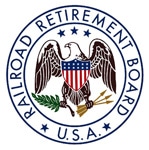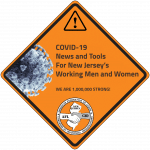
Under the CARES Act, the 1-week waiting period required before railroad workers can receive unemployment or sickness benefits is temporarily eliminated. This applies to an employee’s first two-week registration period for a period of continuing sickness or unemployment beginning after the effective date of the law and ending on or before December 31, 2020.
In addition, the amount of the unemployment benefit is increased by $1,200 per 2-week period. This is in addition to the current biweekly maximum of $733.98 received by most claimants. This increased amount applies to any two-week registration periods beginning on or after April 1, 2020, through July 31, 2020.
The CARES Act includes a separate appropriation of $425 million to pay for this added “recovery benefit,” with an additional $50 million provided to cover the cost of eliminating the waiting period. If these funds are exhausted, the new provisions will no longer apply.
The CARES Act also authorizes payment of extended unemployment benefits to rail workers who received unemployment benefits from July 1, 2019, to June 30, 2020.
Under the legislation, railroad workers with fewer than 10 years of service may be eligible for up to 65 days of extended benefits within seven consecutive two-week registration periods. Workers with 10 or more years of railroad service who were previously eligible for up to 65 days in extended benefits may now receive benefits for up to 130 days within 13 consecutive two-week registration periods.
Since RRB offices are currently closed to the public due to the COVID-19 pandemic, railroad employees are encouraged to file for unemployment benefits online by establishing an account through myRRB at RRB.gov. Employees are encouraged to use a computer rather than a smartphone or tablet due to RRB IT system limitations. Otherwise, applications and claims for benefits will need to be submitted by regular mail. Applications for sickness benefits must be submitted to the agency by mail, or by fax at 312-751-7185. Subsequent claims may be completed online by those with myRRB accounts.
The RRB will also pay sickness benefits and, in some cases, unemployment benefits, to rail workers who have tested positive for COVID-19 or who are subject to a quarantine order. Further guidance on these types of situations is available at RRB.gov/Benefits/Coronavirus.
Tag: COVID-19
On March 27, Congress passed and President Donald Trump signed into law the CARES Act that provides provisions favorable to SMART Transportation Division bus and transportation members as the nation continues to combat the coronavirus pandemic. The bill provides a $2 trillion relief package to the nation as it copes with COVID-19, the novel coronavirus that has killed thousands of Americans.
“This bill helps to provide some short-term relief to the transportation industry that has been staggered by the coronavirus,” National Legislative Director Greg Hynes said. “In the event that public and private entities continue to cut workers or that employees get sick, those workers, including our members, will have extended financial protection.”
This relief bill:
- provides $16 billion in emergency assistance to transit agencies to cover operating costs and direct expenses (e.g., cleaning supplies) at a 100 percent federal share, while preventing the Federal Transit Administration from waiving important labor protections.
- provides the Los Angeles Urbanized Area with $1,178,517,939 divided up among all the transit systems in the region (Los Angeles, Long Beach and parts of Orange County).
- waives the seven-day waiting period for unemployment insurance.
- provides an enhanced unemployment benefit of an additional $600 per two-week pay period.
- provides relief checks up to $1,200 per person, $500 per child. Click here to calculate your amount.
- ensures private insurance plans must cover testing for COVID-19 and any future vaccine without cost sharing.
- prohibits foreclosures on federally backed mortgage loans for 60 days, and up to 180 days of forbearance for borrowers of a federally backed mortgage loan who has experienced a financial hardship related to COVID-19.
Additional federal relief packages may be developed as the country copes with the coronavirus pandemic. Your Washington, D.C., legislative office will continue working to inform legislators and federal officials of the need of frontline transportation workers to be protected. Your union is collecting reports of employers not meeting CDC protocols to prevent COVID-19 transmission and these can be reported on the SMART-TD website.

Sabol has been working closely with the AFL-CIO to distribute information to members, especially those employed by New Jersey Transit, which has been particularly hard-hit by the pandemic.
Apple Inc., in partnership with the U.S. Department of Health and Human Services, including the Centers for Disease Control and Prevention (CDC), released an app and website that guides Americans through a series of questions about their health and exposure to determine if they should seek care for COVID-19 symptoms.
The tool provides CDC recommendations on next steps, including guidance on social distancing and self-isolating, how to closely monitor symptoms, recommendations on testing, and when to contact a medical provider.
This app is designed to help Americans heed CDC guidelines and self-isolate to limit COVID-19 transmission as the pandemic continues.
Users can download the free app from Apple’s App Store or access the tool online at www.apple.com/covid19.
Everyone has a role to play as we work together to stop the spread of COVID-19. The latest recommendations can be found at www.coronavirus.gov.
A few months ago, I had the opportunity to move a lite engine from customer to customer. I like moves like this because they are different from the normal everyday work of a local road switcher. This move was no different from normal railroading, other than this yard bird caught my attention. It was an old U.S. Army EMD SW8 with its original number and livery poking through the faded paint.
My father-in-law is U.S. Army (retired), a bit of a railfan, and he loves this sort of thing. I wrote down the locomotive’s info. and made the move from plant-to-plant. Long after the train was put to bed and I was home, I decided to do a bit of research on this locomotive wondering if it had ties to my father-in-law’s Army career.
To my surprise, I found out this lonely yard bird was a veteran — not just a transportation corps veteran, but a Korean War veteran. This locomotive has been halfway around the world and in a major conflict and is now retired, shifting coal to provide power to southern Maryland, still doing what it was made to do — railroading.
During this health crisis, I look back to my military career as a U.S. Navy Corpsman and also at my current career. Like this yard bird, many railroaders’ paths crossed both in military and railroad service. These two things make us more versatile in the worst of situations, especially in crisis, and more capable to cope with what the railroad throws at us.
Because of this, we can set an example to our fellow railroad workers and our community. Our military backgrounds in discipline, self-reliance and basic medical care are literally life-saving. Our railroad skills of planning, job briefings, safety, situational awareness, and being tasked to fix anything so that the job gets done make us adaptable in any situation. Both careers together make us unstoppable, no matter what life throws at us.
Living in the D.C. area for 20-plus years, I am unfazed by major incidents locally. I’ve been through numerous blizzards, crippling weather and one minor earthquake. Presidential inaugurations, protests and disruptive visits from dignitaries occur frequently. I’ve lived through the D.C. sniper and September 11th attacks — both instances so close that I had shopped at the Home Depot visited by the snipers and had smelled the Pentagon burning 14 miles away.
In all these events, I was essential personnel — tasked to come in both in a medical role and as a conductor. Since 1997, I, like many of us, know that when you are called there is no voicemail or marking off. This coronavirus has caused this to happen again, and it’s now our time to shine.
This crisis may create panic. However, we have what it takes to get through this. We are prepared for long hours, days away from home, and anything thrown at us. We are also nomads who go where the work is. A lot of us are scattered throughout our divisions and stay at different terminals. We can use this to our advantage. You may be able to find needed items that are in short supply at home, in abundance at other locations. They also might be near the terminals or hotels we lay over in.
As union members we can be ahead of the game with our wide network of resources. Members who are coming to another terminal can get with each other and pool resources. If outlying members can get paper towels and home terminal members can get mac and cheese, trade with each other so both benefit. Schools are closing and lots of our loved ones are teleworking now. Helping keep our home fronts happy and safe will take a load off while the carriers are working us harder than ever in this national state of emergency. Getting rest is important, and it’s going to be potentially harder and more stressful. If you live near a fellow member and can help with childcare or other things, let them know. This too will help with a lot of stresses we have. When laying over if you are able to go out and get supplies, go as a crew so you both can get items if your home needs them and there is a limit to get them. Only get what is needed and don’t hoard — this helps no one.
Lastly, if you like hot lunches or get things from the gas station, make sure you’re prepared for those possible closures. Bring non-perishable alternatives so you are not stuck without food at work or away from home.
As always, we are a crew, so look out for each other if you can. Most times we are the only ones who look out for us. We must keep this up by showing unity through this crisis and beyond.
Get to know your local community and your neighbors. They may not know you or your background or even who you are. My neighbors are mostly government workers who only know my odd hours or that I’m the guy who shovels everyone’s walk in a bad snowstorm. With social distancing they know that I’m still working keeping our country moving. I’ve offered to search other stores for provisions that they may need on my way to and from work. Our trash service was delayed, so while having conversations six feet away, I said I was getting in touch with the trash service to plan on an area away from our homes to stage trash if there is a future disruption, remembering my military sanitary training.
As railroaders, we all have this training and these skills. We know when to use them. I had an old timer tell me, “We are not paid for what we do, we are paid for what we know. You must be a proactive conductor, not a reactive conductor.”
Now more than ever I understand what he meant. Use your skills and training to better our workplace and community in this crisis. Be prepared, vigilant and safe. Please look out for each other in this national state of emergency. And absolutely do not put yourself in danger under the guise of a national emergency. We all need to come home the same way we came into work.
With this and all the amazing things I’ve done over my railroading career. I’m really proud that I can provide service to my country once again even if it’s in a small roll like this. This is an amazing time to be a railroader both in great moments and in hardships. We are the nation’s backbone in transportation. We ship more freight in a day than a trucker does in a lifetime. And for over 150 years we have been supplying this nation with its needs. Through two world wars, the 1918 flu pandemic and numerous other hardships, railroaders have come through. We will not let our nation or each other down.
Be safe, brothers and sisters. We will overcome this. Nothing stops a determined union member.
Johnny R. Walker,
Secretary, Maryland State Legislative Board and Legislative Representative, Local 610 (Baltimore, Maryland)

The purpose of this notice is to update you on how COVID-19 is impacting operations at the Railroad Retirement Board (RRB). Be assured, while it is not business as usual, the agency remains open for business. Listed below are some of the more notable changes. Last week, my office sent a press release to rail labor on some of these topics. Hopefully this message will include more detailed information for you and your members.
Field Service Operations:
Last week, my office sent a press release to rail labor advising that field offices are closed to the public. Whenever possible, agency personnel, including field personnel, are working from home. Unfortunately, we expect delays with processing incoming work because as you know, much of our work is not automated. We receive applications and claims for both unemployment and sickness by mail and by fax. Because of safety concerns surrounding COVID-19, staff is only going into the office or to the post office on Tuesdays and Thursdays.
Self-Service Options:
Because of our concern regarding the delay in processing paper applications and claims, we are encouraging railroaders to set up myRRB.gov accounts on the RRB.gov website. I have attached information about all the services available through that account. Please feel free to share with your memberships. With that account, an employee can file for and submit claims for unemployment. A railroader can also submit sickness claims, though not the initial application. Usually, an initial sickness application is either mailed or faxed in from the employee’s doctor’s office to the agency at (312) 751-7185. If an employee is unable to do that or if delays persist, please contact my office at (312) 751-4905 and my staff will assist you in any way they can.
Benefit Payments:
We have received questions regarding the continuation of retirement and disability benefits. Fortunately, that is overall an automated process and we do not expect any delays in paying those already established benefits. In addition, our actuary has assured us that the rail trust funds are well-positioned to pay all retirement, survivor, unemployment and sickness benefits. We are actively addressing questions regarding benefits payable under the RUIA and special circumstances raised by COVID-19.
Legislative Changes:
Related to legislative changes, there have been congressional proposals to remove sequestration from unemployment and sickness benefits; waive the statutory 7-day waiting period for unemployment and sickness benefits; increase the amount of unemployment benefits; and extend the duration of unemployment benefits. There have also been proposals to increase the RRB’s administrative budget in order to account for increased costs related to COVID-19. My staff, along with the agency’s Office of Legislative Affairs and other agency subject matter experts, have worked with congressional staffers as well as your unions to convey the information needed in order for the legislation to move forward.
These are trying times and the agency is doing its best to continue to pay the right people, the right benefits, at the right time. Things are changing quickly and I will update you in the future as the RRB makes adjustments. In the meantime, if you have any questions or problems, I and my staff are always available to assist.
